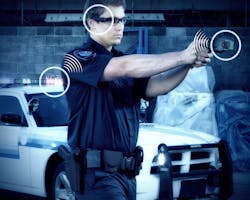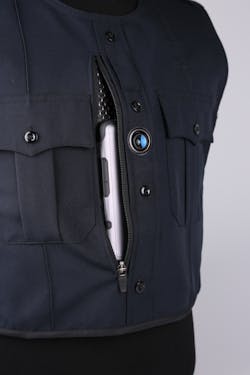In Focus: Advancements in Body Camera Technology
Technology used on patrol has greatly improved over the last decade. Recently, advances in technology are simple, yet effective, allowing officers to have high-quality technology at their fingertips and on their uniforms. One technology in particular has been steadily making its way into law enforcement agencies for years—body worn cameras (BWCs). On-going changes in BWC technology over the years, primarily driven by law enforcement feedback, have led to a smaller, more durable, longer lasting, integrated product with truly modern features.
A product to fit customer needs
Five years ago, older model BWCs were bulky, making it awkward for officers to wear comfortably and discretely, which added fear of the camera falling off during an altercation. And at one time, most BWCs were limited in regard to their field of view ability and their battery life. Today, the technology behind each BWC design is much more intricate than it was previously.
Steve Tuttle, vice president of strategic communications at Axon says their body cameras have come a long way since their first design. Though the technology itself was well accepted, officers had trouble adjusting to its bulky design. Using feedback from customers, Axon redesigned its camera, introducing the Axon Flex. The company then developed Axon Body which has now been engineered into Axon Body 2 and Axon Flex 2. With each model came even more refined technology. The Axon Body 2 records in low-light and HD and uses Wi-Fi to stream videos. The Axon Flex 2 has a 120-degree field of view. Both are able to last up to 12 hours.
Furthermore, the Axon camera is able to record footage with the capability of mimicking the human retina. Departments may also choose from varying buffering settings with an option of 30, 60, 90 or 120 second buffers. This allows the camera to record only video and may capture events within the set time frame. “Once a department chooses which buffering setting they would like, that setting affects all of the cameras within that department,” says Tuttle. The Axon Signal technology can also turn the camera on when the car door is opened or the light bar is activated, truly creating a smart device.
The connected officer
Having an integrated system is advantageous on patrol, and many companies are providing solutions to connect the officer. Technology advancements have included integration with in-car systems.
WatchGuard Video’s VISTA XLT two-piece BWC system not only offers interchangeable head and body-mounted cameras, but one or more cameras and a 4RE in-car system can work together as a single system, allowing you to capture synchronized video of an event from many points of view.
The integrated technology offered now even extends to the officer’s holster. The Safariland Group has come up with a fast acting holster in its 7TS. The holster is equipped with the Camera Auto-Activation System (CAS) which is automatically triggered when a firearm is drawn out of the Safariland 7TS series duty holster. The moment the firearm is removed from the holster, the body camera continually records until the officer stops it. It is also able to capture footage that happened 30 seconds prior to when the activation is initiated. “With CAS technology, an officer can stay focused on critical events at hand without having to think about manually turning on a VIEVU body-worn camera or other communication systems,” says Safariland Chief Technology Officer Terry O’Shea. “With transparency and trust top of mind, CAS technology is becoming an essential tool to enhance officer protection and performance.” Implementing the sensor into the holster allows officers an added safety feature during critical situations.
Environment was also considered; the holster is able to work well in conditions such as -40 degrees Fahrenheit to 130 degrees Fahrenheit. O’Shea says the company took into consideration feedback from customers who had used earlier models. “We updated the battery to one that was also compatible with the one they use in their flashlights and duty gear.”
Wi-Fi is also implemented in Safariland’s VIEVU LE5 camera, allowing officers to connect to CAS and smartphones to use the VIEVU application. There they can easily download videos and manage video footage. This camera also has a field view of 70, 95 and 120 degrees. Representatives at Safariland say the USB-C download cable is fast-charging and fully reversible for a simplified docking process.
The bigger picture
Body cameras have proven to have many uses aside from basic video recording. Utility’s BodyWorn is sleek in design and is able to accomplish multiple tasks aside from basic video recording. In fact, this particular camera is able to detect gunshots. Once a gunshot is detected, the camera begins recording with both audio and video. The device is able to record up to two minutes of footage prior to the actual event. Once engaged, the camera sends an alert to dispatch as well as any units that may be close by for the officer. “We focus on policy based recording,” says Chris Lindenau, chief revenue officer of Utility.Officer safety was also top of mind in the design. BodyWorn has an ‘officer down’ feature that detects when an officer is down, which will then alert the officer’s department and offers exact coordinates of the officer’s location. If an altercation is beginning to take place, the camera will also detect this. Footage from BodyWorn automatically loads off of Wi-Fi making it easy and convenient for officers to upload video footage after their shift. BodyWorn has been able to integrate their camera with smartphones making the device ideal for the officer’s uniform. The device also uses cellular activation, is shock resistant and water resistant. “Our goal is to focus on converging technology,” says Lindenau. “Technology can help improve police officers’ efforts, especially in regard to transparency.” Utility would like to integrate other systems such as CAD, traditional radio and expand the capabilities of artificial intelligence for police departments.
Since technology has advanced, departments can utilize their BWCs in other areas of policing, too. For instance, many agencies will use the footage captured later on as training guides. The newly developed clarity found in most body cameras and the expanded field of view on most allow the images to be much sharper and allow officers to view everything going on at a scene.
Current body cameras have high-resolution video as well as clearer audio capabilities, strengthening the quality of evidence collected. This is especially helpful when BWCs are utilized in regard to more than simply recording events at a scene. Audio clarity makes them ideal for interviews, including witness interviews, which may help clarify a situation and add to the amount of evidence collected.
BWC evidence can assist officers too by relieving the burden of paperwork and by providing officers clarity on small details they may have missed during the incident, says Safariland’s O’Shea. Additional information may be retrieved for reports due to recording options that capture footage before and after a specific event. This feature provides additional context of an encountered situation that may help officers uncover unnoticed, critical details about a situation.
BWCs provide support, evidence and protection for officers and they often bridge the gap between departments and civilians. These benefits will continue as BWC technology continues to evolve and improve over time. All body cameras give police departments the opportunity to provide added safety for their officers while still giving transparency to the communities they serve.
About the Author
Hilary Romig is currently a Crime Scene Investigator and Evidence Technician at the Ruidoso (NM) Police Department. She has written for several public safety publications and has extensive law enforcement training.
On Patrol: Two Agencies Integrate Axon BWCs

Hilary Rodela
Hilary Rodela is currently a Surveillance Officer, a former Private Investigator, a former Crime Scene Investigator, and Evidence Technician. She worked for the Ruidoso (NM) Police Department as well as the Lubbock (TX) Police Department. She has written for several public safety publications and has extensive law enforcement and forensic training and is pursuing forensic expertise in various disciplines. Hilary is a freelance public safety writer and curriculum developer for the National Investigative Training Academy.





